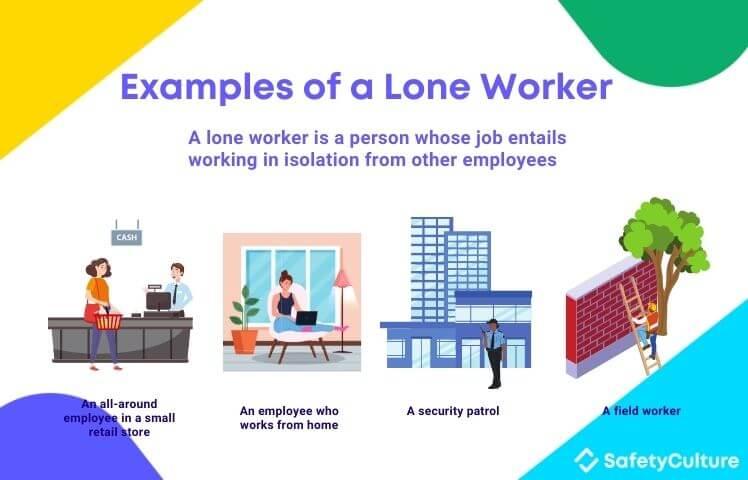What is Lone Working?
Lone working is a labor setup where an employee is operating alone in an isolated area or where other employees cannot see or hear them. It is an arrangement in which supervisors or other colleagues cannot provide direct support since they are not physically present in the specific area. It does not necessarily mean that an employee is physically alone onsite or in a building, but they may be in a separate location from the rest of their team. Lone working is prone to higher risks of exposure to workplace hazards due to lack of assistance and supervision.
Who is Considered a Lone Worker?
Employees who are working by themselves in a specific area or workplace are called lone workers. Some examples of lone workers are those who work in the field, security personnel working on graveyard shifts, electricians who work on light posts, employees working from home, company concierge or messengers, and those who work separately away from their colleagues such as someone doing the inventory audit solely in the stock room of a retail store.

Examples of a Lone Worker
Government Guidelines
Different states provide various guidelines but they aim for the same goal — to secure the safety of lone workers. According to the British Crime Survey, an estimate of 150 lone workers are physically or verbally attacked every day in the United Kingdom alone. That is why the Health and Safety Executive (HSE) set forth guidelines for employers to protect lone workers.
While for the United States, although there are no other federal Occupational Safety and Health Administration (OSHA) rules that specifically apply to lone working, requirements of health regulations still apply.
In Australia, employers must monitor the health and safety of their employees, including the assurance of effective communication with workers working remotely or in isolated conditions. This is under Regulation 48 from the Managing the Work Environment and Facilities Code of Practice 2011.
Common Hazards of Working Alone and How to Avoid Them
Lone working is a legal form of employment and there is no general legislation that prohibits the employer from letting their employees work alone. However, they must be aware of any specific legislation on lone working in different industries such as supervision in diving operations, construction processes, and others. Here are common hazards associated with lone working and how to prepare for them or avoid them.
- Physical Injuries
Accidents may happen anytime and in any situation. Common hazards including slipping, tripping, falling, or electrocution are the most common causes of physical injuries. Lone workers may experience these hazards and it would be difficult for them to seek help since they are working alone. Employers should proactively provide a ready-to-use first aid kit and emergency contact numbers as a preparation for this kind of situation. - Stress and Mental Health Issues
Aside from physical risks and workplace hazards, lone working can also cause stress and mental health issues. Being unable to communicate issues may cause lone workers to feel isolated or disconnected resulting in low productivity, sickness, or, worse, resignation. It is the employers’ responsibility to keep them safe, secured, and supported even if they are working alone. Checking with them via phone calls or sending messages can ease the feeling of isolation. - Violence
It is a high risk for lone workers to be involved in violence since there is no one to intervene or call for help in an emergency. Lone workers should be properly trained on how to handle this type of situation and it must be reported immediately, even if, in some cases, it was just a simple argument. - Sudden Illnesses
Lone workers can be exposed to sudden illnesses that could hold the production timeline. Open communication with lone workers can help adjust the situation and send manpower replacement to prevent production delays. - Inadequate Provision of Welfare Facilities
It would be hard for lone field workers to find welfare facilities since they are away from the main site. But lone workers’ awareness of this situation can help manage their expectations. Also, it is their responsibility to take reasonable care to look after their health.
What Must the Employer of a Lone Worker Do?
Lone workers have a greater risk of hazards as they work alone and have limited access to get help if things go wrong. They are vulnerable and prone to high risks including violence. That is why in the United Kingdom employers are required by the Safety, Health, and Welfare at Work Act 2005 (Section 19) to conduct risk assessments to determine whether an employee can work by themselves or a task can be carried out by a single person. All employers should secure the following:
- Lone worker protection
It is vital to let lone workers know the emergency procedures and ensure they know how to operate emergency systems or devices. As an example, if there is a readily available first aid kit in case of physical injuries, employers should ensure all items in the kit are within their use-by dates and lone workers know where to find and how to use them. - Lone worker monitoring
Management must monitor lone workers and keep in touch with them. They might not be physically present, but they have to make sure lone workers understand the processes, procedures, and devices they are using in performing their tasks. The supervision is minimal, but they still need to coordinate with lone workers once in a while to check their status and get updates on the progress of their work. - Lone worker training
Training is paramount in all industries. All employees, especially lone workers, should undergo training before proceeding with their tasks to identify gaps and address issues immediately as they will be supervised minimally. Training would help them, for example, in identifying Hazard Analysis Critical Control Point (HACCP), coping up with unexpected situations, and knowing when to ask for help. - Lone worker solutions
Conducting lone worker risk assessments can help evaluate the workplace and identify hazards. It helps employers to mitigate controllable risks immediately and assess rampant issues to implement control measures based on the Hierarchy of Controls. Telecontrol measures or off-site monitoring and control via an app, are enforced to ensure lone workers can urgently ask for assistance if an abrupt incident occurs. - Lone working policy
A lone working policy is an official document that covers the responsibilities of employers and lone workers to ensure the safety of both parties. It includes workplace hazards, employee health and safety risks, training needs, and standardized procedures when an incident occurs.
Create Your Own Lone Working Checklist
Eliminate manual tasks and streamline your operations.
Get started for FREEGuidelines When Creating Lone Working Policy
When an employer is establishing safe work arrangements for lone workers, they need to know the standards and laws that may apply to the specific work activity. They must evaluate processes and check if the requirements can be met by a lone worker. Here are some points that need to be addressed when creating lone working arrangements:
- risks of the task can be controlled adequately by one person;
- suitability of operator to work alone;
- managing stress and other health issues;
- training needs to ensure competency in safety matters; and
- supervision and monitoring processes.
How Can SafetyCulture Help with a Lone Working Policy?
Employers may find lone working policies tedious and burdensome since it has to be scrutinized from creation to implementation. Many factors and processes can come into play when organizing policies including conducting risk assessments. The process usually takes time because it involves going through multiple hands for review and completion. Which in turn, opens the whole process to issues like losing track of paperwork or records.
SafetyCulture (formerly iAuditor) is a cloud-based inspection app that can be used to replace paper forms. It helps organizations to have everything they need in one place. You can track hazards, risks, control measures, and assign corrective actions while performing risk assessments. Lone working policies are securely saved in the cloud and can be accessed by all parties involved any time, anywhere even if they are offline. There are also courses on lone working available through Training, as well as the necessary tools to create your own learning modules as needed.
To save you time, we have created ready-to-use lone working templates you can download for free and it is fully customizable, or you can check out our Public Library of free checklist templates that can be used not only by lone workers but by any employee in almost all industries. You also have an option to convert your existing PDF, Word Document, Excel, or PowerPoint files into SafetyCulture checklists for free up to 3 files.
SHEQSY: Tools to Safeguard Lone Workers
Once you complete your risk assessment with SafetyCulture, you may find that the easiest and most affordable way to safeguard your lone workers is with a lone worker safety solution. Ideally, you should deploy a solution that can be customised to suit your organisation’s unique lone worker policies, management processes, and lone worker procedures.
SHEQSY is the leading lone worker safety solution that protects employees in real-time and makes it easy to manage, monitor and report on lone worker activities from one user-friendly dashboard.
SHEQSY can be simply deployed across your lone workforce as a smartphone app (iOS/Android), protecting employees in real-time with simple and discreet duress activation, periodic check-ins, and overtime alerts.
In addition to the smartphone app, SHEQSY integrates Bluetooth wearables and handheld satellite devices to deliver a truly enterprise-grade safety solution.
Employees can submit near-miss, hazard, and incident reports (accompanied by images and videos) in real-time. Meanwhile, SHEQSY records all historical lone worker data (such as dates, times, locations, work activities, pre-start form responses, location notes, hazard reports, and more) and stores it in the SHEQSY Management Dashboard. The ability to run detailed reports is invaluable when completing lone worker risk assessments.
From quick duress activation and periodic check-ins, to hazard reporting and calendar scheduling, SHEQSY makes lone worker safety easy and effective. Ready to safeguard your employees? Contact SHEQSY now to schedule a demo and start your 30-day free trial.




